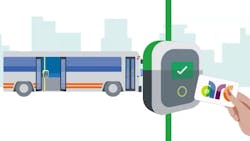New region-wide fare collection system coming to greater Edmonton region
A new state-of-the-art regional electronic fare payment system is being phased in throughout the greater Edmonton region in Alberta, Canada.
Arc, an account-based system, will be available to transit users in Edmonton, St. Albert, Strathcona County, Fort Saskatchewan, Leduc, Spruce Grove and Beaumont and aims to make paying for transit easier and more convenient.
“Arc symbolizes forging a path between two points, much like how transit connects us to vital services, each other and our region. We did a lot of research to identify names that would reflect the purpose of our program and weren’t already in use,” said Edmonton Transit Service (ETS) Branch Manager Carrie Hotton-McDonald. “We held focus groups with members of the public to test names and narrowed it down to Arc. Arc is a continuous movement between points from A to Z and is also a symbol of continuity, growth and movement, exactly what we were striving for in the greater Edmonton region.”
The system includes an Arc card that can be tapped when entering and exiting buses and the LRT on all seven participating transit systems. Arc fare validators are installed at the front and back doors of all buses in participating regions, as well as the entrances to LRT stations. Arc fare vending machines are being installed throughout the LRT network in Edmonton and at key regional transit transfer locations.
Arc benefits include:
- Instantly available funds;
- Money is stored in an Arc account, not on the card itself;
- Balance protection if the card is registered online;
- Daily and/or monthly fare capping;
- Autoload capabilities; and
- An independent website that will launch late summer/early fall, where users can purchase and reload their cards.
“The technology itself is constantly being refreshed, so the latest technology, whether it’s the Arc fare vending machines or the Arc card readers, at the moment, those are all state-of-the-art. With our vendor we have the process where we will do a mid-operational refresh to make sure all the technology and hardware is as up to date as possible, including our point of sales systems as well as the card readers,” said Cameron Grayson, director of Transit Innovation Programs, ETS.
The new system will be rolled out in phases with continuous testing, with the first phase starting this July for residents in Edmonton, St. Albert and Strathcona County. The initial pilot will run through August 2021 and will be available to a select group of people who use regular adult fares, post-secondary students who use a U-pass and transit staff across the region. Arc will be available to all adult regular fare customers and post-secondary students who use U-Pass in fall 2021.
Hotton-McDonald explains a staggered launch will allow the municipalities to work out any kinks in the system, minimize disruptions and get the majority of riders onboard with the new technology before expanding access to fare groups that require additional support.
Phase 2 is scheduled to begin in 2022, when it will expand to seniors, Ride Transit Program users, youth, junior and high school students, low-income individuals and paratransit users.
Grayson notes the total project cost was a little bit more than C$50 million (US$41.26 million), with the city of Edmonton contributing around C$18 million (US$ 14.85 million), Strathcona County and St. Albert contributing about C$5 million (US$4.12 million) and the remaining approximate C$29 million (US$23.93 million) came from provincial funding via a degree trip fund.
As the region continues to recover from the pandemic, stakeholders from the municipalities agree this new technology is a great incentive to encourage riders to start using transit by making it simpler and easier.
“We saw it as an advantage to have the same fare payment program that existed in Edmonton and throughout the region. We wanted to be consistent; that was a major goal of this project,” said Will Steblick, service delivery manager, St. Albert Transit.
Director of Strathcona Transit Wade Coombs added, “What we were looking for here with Edmonton leading this process was to have a system that is region wide, that one card gets you on all systems. It’s going to encourage ridership by opening a whole region up to riders; no matter where you live, you can travel anywhere in the region on any transit system with one card. The system has the flexibility to create new fare incentives to encourage people. There is so much more we can do with this system to encourage ridership.”

Megan Perrero | Editor in Chief
Megan Perrero is a national award-winning B2B journalist and lover of all things transit. Currently, she is the Editor in Chief of Mass Transit magazine, where she develops and leads a multi-channel editorial strategy while reporting on the North American public transit industry.
Prior to her position with Mass Transit, Perrero was the senior communications and external relations specialist for the Shared-Use Mobility Center, where she was responsible for helping develop internal/external communications, plan the National Shared Mobility Summit and manage brand strategy and marketing campaigns.
Perrero serves as the board secretary for Latinos In Transit and is a member of the American Public Transportation Association Marketing and Communications Committee. She holds a bachelor’s degree in multimedia journalism with a concentration in magazine writing and a minor in public relations from Columbia College Chicago.


